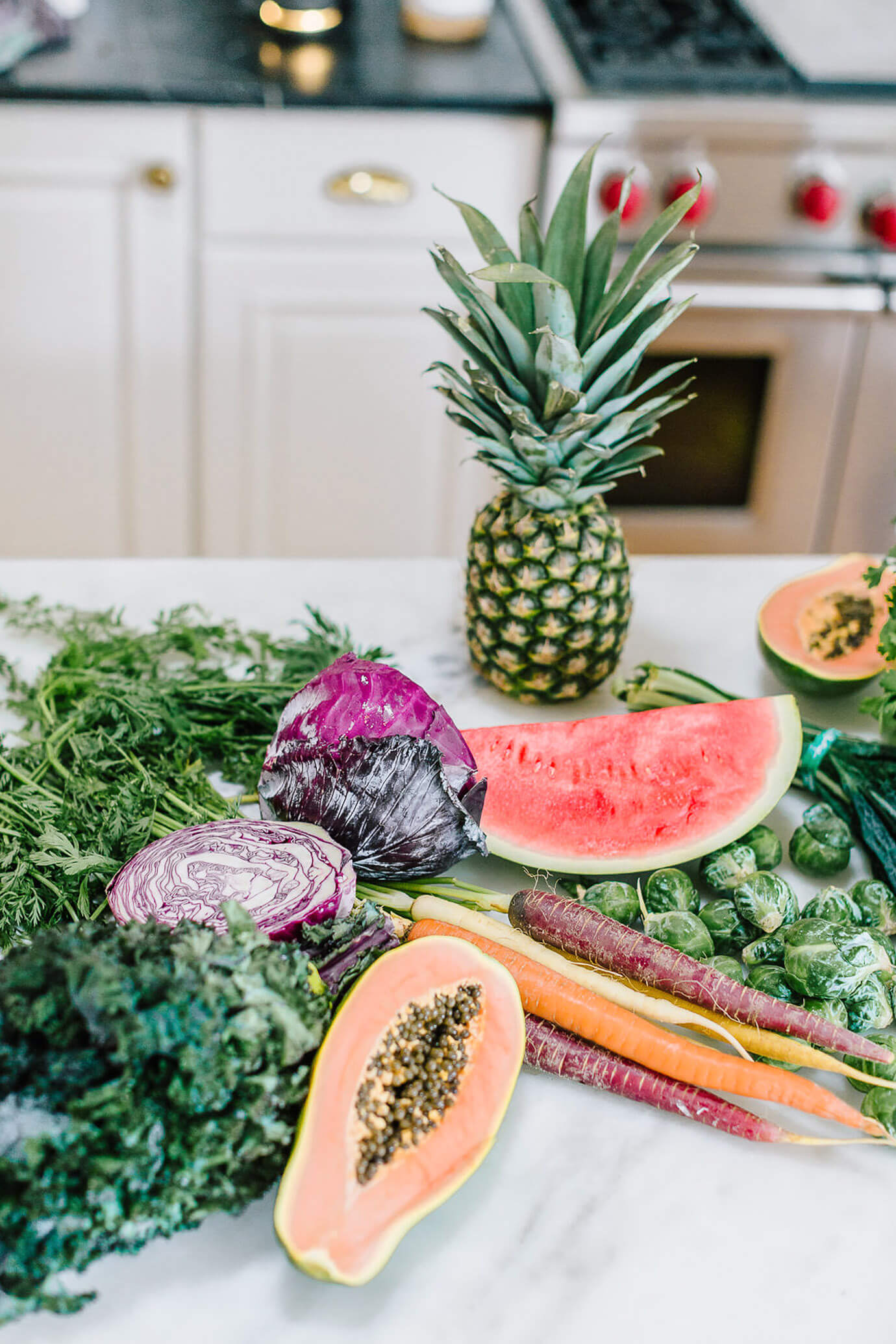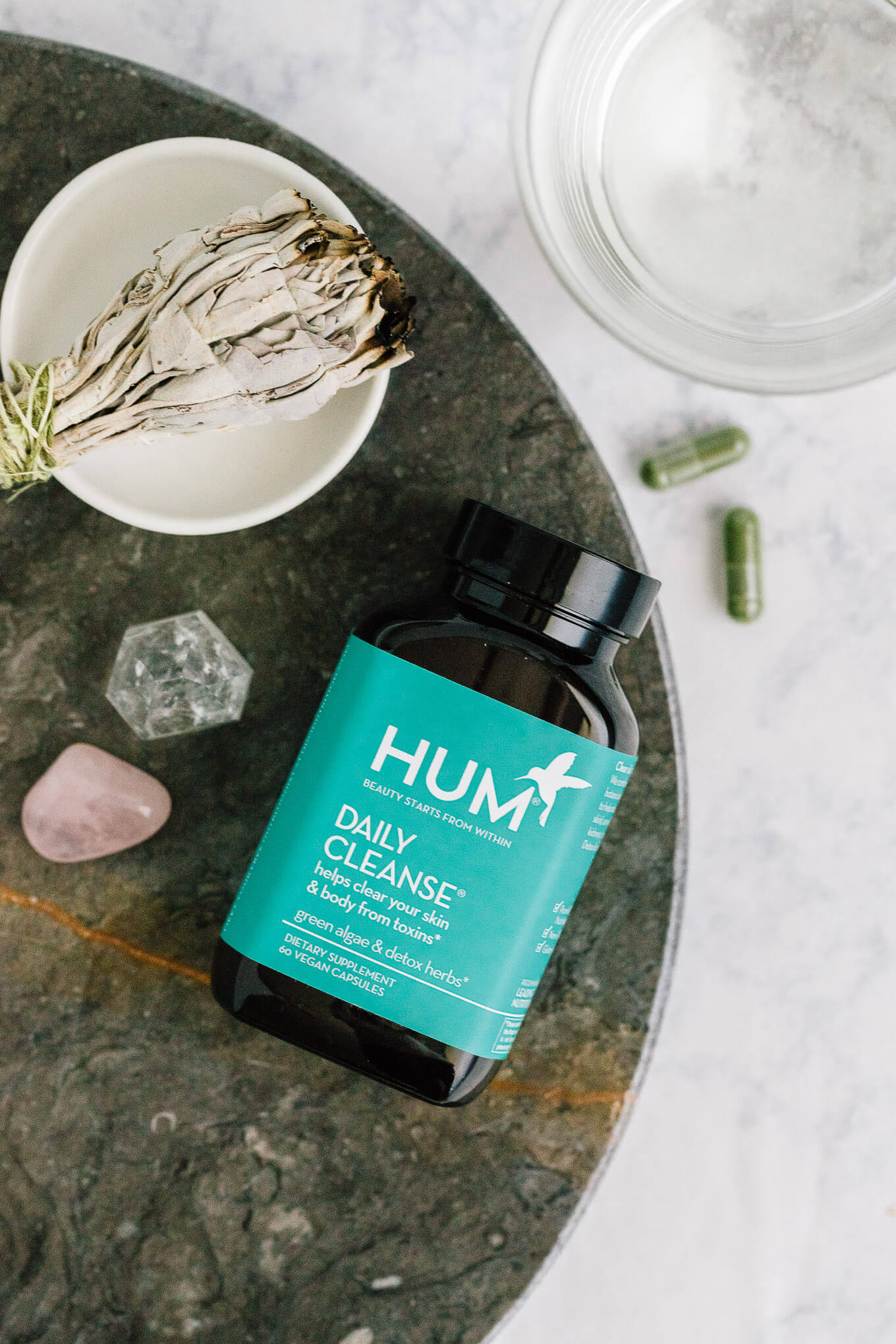Consider this your science-based guide to understanding how your body detoxes naturally. This guide explains what it means to detox and how your body’s detox pathways work. Plus, tips on how to support your natural detoxification pathways. No juice cleanse required!

Unfortunately, the term detox has become synonymous with a restrictive diet or a way to cleanse the body from a weekend of overindulging with food or alcohol. It typically implies following a specific diet or using expensive products that claim to rid your body of toxins, which in turn improves your health and promotes weight loss. And I get it. It’s enticing to jump on board the next 3-day detox marketed to give you a boost of energy and finally lose those last 5 pounds when you’re desperate for change.
But as a registered dietitian, I urge you to reconsider what it actually means to detox. The truth is your body is incredibly well-equipped to eliminate toxins. Your body’s detox pathways work around the clock to keep you alive. You can’t just turn these detox pathways on and off.
That being said, just because we have a built-in detoxification system doesn’t mean it’s always functioning optimally. Sometimes your detoxification pathways need extra support. Confusing right? I promise it doesn’t have to be. The best way to detox is by supporting your bodies’ innate detoxification system on a daily basis through nutrition and lifestyle practices. But first, it’s important to understand how your body detoxes naturally.

What Is Detoxification?
Detoxification is the body’s process of removing toxic substances. Despite the marketing around a detoxing, it’s actually an ongoing process that your body does all on its own in order to survive. Your main detoxification organs are the liver and kidneys. Additionally, your lymphatic system, digestive tract, skin, and lungs also play a part in how your body detoxes. Altogether, these organs create detoxification pathways in the body.
What it’s not
It’s worth mentioning that true detoxification isn’t a diet. Or rather you don’t need a restrictive diet, juice cleanse, or expensive kit to detox. The marketing around selling detoxes catches people in a vulnerable state when they’re desperate for change. Most people (even if unintentionally!) approach detox with a “quick-fit mindset” hoping the detox or cleanse will give them the results they’re looking for in terms of health.
Unfortunately, this typically turns into another form of yo-yo dieting or a restriction-binge cycle. It’s not a sustainable way to live or create forever wellness. Optimal health comes from a slow and steady approach to changing habits through nutrition and lifestyle choices that align with your values. Not as “sexy” as the quick-fix promises of a detox diet, right?
But you can create a lifestyle that incorporates supporting your detoxification pathways daily. As mentioned above, I encourage you to approach detoxing as a lifestyle or a daily act of self-care.
WHAT ARE WE DETOXING FROM?
Like the phrase detox, “toxins” can take on a different meaning depending on who’s talking. Toxins fall into two main categories, internal and external toxins. Internal toxins include lactic acid, urea, and waste products from microbes in the gut that occur during natural metabolism. External toxins come from outside the body and introduced by eating, drinking, breathing, or are absorbed through the skin.
Now more than ever, we face countless exposures to external toxins like chemical compounds and environmental pollutants. This happens on a daily basis even if we try hard to limit toxin exposure. In fact, it’s estimated to be more than 80,000 chemicals that fall into the category of food additives, food packaging, and environmental chemicals.
Examples of Daily Toxins
These are just a few examples of toxins and where you may come into contact with them on a daily basis include:
-
- Outdoor air – pollutants in the air including exhaust, tobacco smoke, particles from industrial emissions, etc.
- Indoor air – pollutants trapped in the air including mold, tobacco smoke, chemicals released from cooking, furniture, carpet, construction materials, etc.
- Drinking water – tap water contaminated with pesticides, herbicides, heavy metals (lead, mercury, arsenic), and chemicals from agricultural runoff.
- Food – chemicals such as pesticides and heavy metals consumed through food due to agricultural practices and environmental contamination. Overconsumption of processed foods, food dyes, preservatives, drugs, and alcohol.
- Household products – food containers, cleaning products, fertilizers, weed killers, bug spray, etc.
- Beauty products – skincare products, makeup, deodorant, hair products, etc.
As you can see, we may be exposed to numerous toxins throughout the day. These toxins are foreign to our bodies and can negatively impact different facets of health. Research shows a link between certain toxins and chronic inflammation and autoimmune diseases. When our body detoxification pathways aren’t functioning optimally it can drastically affect our digestion, energy, mental clarity, anxiety, and especially, our skin. Since your skin is a key player in detoxification through sweating, a build-up of toxins can appear on the skin in the form of acne and rashes.

How the Body Detoxes
Now that we know the types of toxins our body’s our exposed to on a regular basis, let’s dive into how the body gets rid of them. Without going too in-depth into the science, this section breaks down each organ’s role in the detoxification process.
The Liver
Think of the liver as the master detoxifier. It acts as a filter removing toxins that our body produces as part of normal metabolism. The liver breaks down these toxic byproducts so they can then be filtered out through our kidneys. It also helps our body eliminate pathogens like viruses and bacteria, cholesterol, hormones, and external toxins, including alcohol, drugs, chemicals, heavy metals.
The Kidneys
Like the liver, the kidneys also act as a filter. They filter waste and undesirable substances like medication byproducts and harmful chemicals out of our bodies. In addition, the kidneys keep our body in balance by regulating fluid and electrolyte balance. This is vital for maintaining your body’s pH balance, allowing your cells to perform their functions, and controlling blood pressure.
The digestive tract
One of the many roles of the intestinal tract is supporting detoxification. The intestinal tract helps expel toxins through bowel movements. This requires maintaining proper gut health through eating enough fiber and nurturing the trillions of microorganisms living in our guts. When we eat fiber from whole-food plant-based sources this acts as bulk bushing the intestinal tract and helping eliminate the substances like heavy metals, chemicals, and excess hormones through the intestinal tract. It also supports the good gut bacteria, while helping reduce an overgrowth of harmful bacteria and yeast.
the lymphatic system
Lymph is the fluid that circulates through the entire body. It’s part of the larger immune system whose essential role is to protect our cells from foreign substances and eliminate them from our bodies. The lymphatic system consists of your spleen, thymus, adenoids, tonsils all connected by a web of capillaries, vessels, and hundreds of lymph nodes. This unique system plays a large role in detoxification, with its main job of transporting white blood cells (aka lymphocytes) that help fight infections and protect against harmful toxins.
the respiratory system
Starting with the nose, the little hairs inside your nostrils create a protective barrier to help keep particles like dust and dirt out of our lungs. The mucus that coats your nose and lungs creates a second protective layer. Finally, when you breathe in oxygen, the lungs and bronchi help convert toxins into carbonic gas (CO2) which you then exhale.
the skin
Think of the skin as the body’s defense system. As the body’s largest organ, the skin creates a barrier protecting us from bacteria, viruses, and chemical toxins that shouldn’t enter our bodies. The skin also allows for the detoxification process to happen through sweating.
While the liver and kidneys do most of the heavy lifting when it comes to detoxing, they’re not always able to get rid of all the toxins. What doesn’t leave gets stored in the fat. When the body sweats it can rid the toxins like heavy metals, arsenic, lead, and mercury through this secondary system.

How to Detox the Body Naturally
Although the body detoxifies on its own, we can still support it daily to keep it functioning optimally. Rather than going on a restrictive diet or juice cleanse, I recommend focusing on adding daily nutrition and lifestyle practices that naturally support your body’s detox pathways.
Below are my top 5 ways to support detoxification on a daily basis. Keep in mind these five nutrition and lifestyle practices aren’t the only ways to support detoxification. If you’re looking for more ways to reduce your exposure to toxins and incorporate more detoxification practices, check out this post (coming soon!).
1. Focus On Food
It’s no surprise adequate nutrition plays a role in proper detoxification. The food is powerful. Eating a balanced diet is the perfect way to help fuel the organs and systems that do the heavy lifting. Focus on a plant-based diet that has a foundation in fruits and vegetables, complex carbohydrates, healthy fats, and protein.
To optimize your way of eating to support detoxification, focus on antioxidant and fiber-rich foods while reducing excess sugar and processed foods. High-fiber foods like greens, vegetables, lentils, and nut and seeds can also help support proper digestion and bowel movements reduce —aka removing toxins.
Research shows a link between the intake of high-sugar foods and beverages and poor liver function. This adds to our toxin burden along with the 10,000 chemicals allowed in our foods and food packaging. Limiting foods that have added sugars, preservatives, and other ingredients that distract the liver from its normal function can help support our detoxification process as a whole.
The good news? A plant-based diet checks all of these boxes.
2. NOURISH Your GUT MICROBIOME
We know that the digestive tract is one part of how your body detoxes. Supporting gut health on a daily basis is one of the best ways to ensure a properly functioning digestive tract.
A healthy gut has a diverse microbiome balanced with good and bad bacteria. Eating plant-based whole foods that are naturally rich in fiber supports your gut microbiome. As mentioned above the fiber helps bulk up and push out waste. Taking that a step further, certain fibers called resistant starches act as a prebiotic. Prebiotics act as food for probiotics, the good bacteria that help create an environment optimal for efficient digestion and other health processes.
Focus on eating fiber-rich whole foods at each meal and incorporating fermented foods into your daily diet. I also recommend supplementing with prebiotics and probiotics to ensure you’re nurturing your gut microbiome daily.
3. Hydrate
Your body is made up of 70% water. If not properly hydrated it’s impossible for your body to function optimally. This includes the detoxification process.
Staying adequately hydrated helps flush out toxins through your kidneys which you excrete through urine. It also helps remove harmful cell byproducts like urea and carbon dioxide from the bloodstream. Once filtered from the blood, water pushes out toxins through other detox channels like breathing and sweating.
4. Move Your Body
Moving your body daily is a great way to increase lymphatic circulation and supports how your body detoxes. Low impact movement to incorporate daily to promote detoxing includes walking, form rolling, and yoga. Additionally, exercising intensely enough to break a sweat is like a two-for-one in terms of detoxification. You release toxins through sweating as well as supporting other detoxification pathways through increased circulation, nutrient delivery to your cells, and promoting digestion.
5. Support with Supplements
You may also consider supplementing with a more concentrated source of foods or compounds that support the detox pathways.
Certain detoxifying greens like chlorella, a nutrient-packed alga, can magnify our body’s toxin elimination process. This superfood is classified as a chelator, which simply means it binds to and deactivates heavy metals. For example, one study found that participants who supplemented with chlorella experienced lower heavy metal levels (including mercury, silver, tin, and lead) compared to those who didn’t supplement. Since chlorella isn’t exactly something you can pick up fresh at your grocery store, I recommend HUM Nutrition’s Daily Cleanse. This unique supplement pairs chlorella with other gentle detoxifying ingredients like spirulina, dandelion leaf extract, and red clover.
Think of Daily Cleanse as a daily self-care practice. It’s an easy addition to your daily routine that supports how your body detoxes by removing unwanted toxins that arise from the chemicals in processed foods and pesticidal agriculture. Daily Cleanse works by supporting your body’s natural detoxification pathways with 14 plant extracts, vitamins, and minerals. It’s especially beneficial for flushing your body of toxins that can cause breakouts. It’s truly supporting your body from the inside out.

The Bottom line:
As you can see, our bodies are always in some state of detox. Since we face countless exposures to toxins on a daily basis, the body constantly works to cleanse itself from toxins that can negatively impact our health. Toxins can drastically affect our skin, digestion, energy, and more.
Our liver, kidneys, digestive tract, lymphatic system, respiratory system, and skin make up our detoxification pathway. They work around the clock to flush out toxins. Pretty amazing, right?! In order to keep this detoxification process working optimally, it could use a little support. Rather than a restrictive 7-day juice cleanse, focus on nutrition and lifestyle practices that upregulated how your body detoxes daily.
You can give your body a boost by going back to basics. Eating more antioxidants, fiber-rich whole foods, reducing sugar, staying hydrated, moving your body, and supplementing with detoxifying greens all support detoxification daily. This lifestyle approach to detoxification is truly much more effective than any cleanse or detox diet. Supporting how your body detoxes daily with sustainable habits is the best way to care for yourself and create your forever wellness.
This post was created in partnership with HUM Nutrition. As always, I only partner with brands I love and use. I share them because I want you to love them as much as I do. Thank you so much for supporting the sponsors that keep Nourished by Nutrition going!
References:
https://my.clevelandclinic.org/health/articles/7041-the-structure-and-function-of-the-digestive-systemhttps://www.todaysdietitian.com/newarchives/030314p34.shtml
https://www.nccih.nih.gov/health/detoxes-and-cleanses-what-you-need-to-know
https://onlinelibrary.wiley.com/doi/full/10.1111/jhn.12286
https://www.health.harvard.edu/staying-healthy/the-dubious-practice-of-detox
https://pubmed.ncbi.nlm.nih.gov/25522674/
https://www.ncbi.nlm.nih.gov/books/NBK279393/
https://pubmed.ncbi.nlm.nih.gov/26762459/
https://www.niddk.nih.gov/health-information/kidney-disease/kidneys-how-they-work?dkrd=hispt0004
https://www.ncbi.nlm.nih.gov/pmc/articles/PMC4488002/
https://www.ncbi.nlm.nih.gov/pmc/articles/PMC3567429/
https://www.ncbi.nlm.nih.gov/pmc/articles/PMC4377870/
https://www.ncbi.nlm.nih.gov/pmc/articles/PMC2947764/
https://www.ncbi.nlm.nih.gov/pmc/articles/PMC4734693/
https://pubmed.ncbi.nlm.nih.gov/23609775/
https://pubmed.ncbi.nlm.nih.gov/19724292/
https://www.ncbi.nlm.nih.gov/pmc/articles/PMC1566242/


[…] https://nourishedbynutrition.com/how-your-body-detoxes-naturally/ […]
[…] https://nourishedbynutrition.com/how-your-body-detoxes-naturally/ […]
[…] https://nourishedbynutrition.com/how-your-body-detoxes-naturally/ […]
Hi! What facial cupping tools would you recommend purchasing?
[…] https://nourishedbynutrition.com/how-your-body-detoxes-naturally/ […]
[…] Your body is a remarkable machine with sophisticated toxin removal techniques. Multiple organs work together to eliminate harmful substances. This complex system keeps you healthy around the clock3. […]
[…] glutathione plays a crucial role in the body’s natural detoxification process. It helps the liver eliminate toxins, builds and repairs DNA, and strengthens the immune system. […]
[…] fact is, your body already has a sophisticated detoxification system in place, primarily consisting of your liver and kidneys. These organs work tirelessly to eliminate […]
[…] The benefits of hangover drip extend far beyond mere symptom relief. Along with rehydrating the body, they replenish essential nutrients depleted during alcohol consumption. Additionally, hangover drips can reduce inflammation and oxidative stress, helping to alleviate discomfort and support the body’s natural detoxification processes. […]
[…] fruits, vegetables, herbs, and herbs. Detox drinks’ main goal is to assist your body’s natural detoxification processes by removing harmful substances that can build up over […]
[…] 7-Day Cleanse works by providing a synergistic blend of natural ingredients that support the body’s detoxification pathways. These ingredients target various organs and systems involved in detoxification, such as the liver, […]
[…] https://nourishedbynutrition.com/how-your-body-detoxes-naturally/ […]
[…] mechanisms. From widening blood vessels to increasing blood flow, niacin ensures that the detox pathways are not just open but are flowing with […]
[…] tea leaves, and natural ingredients that are marketed as beverages that can aid the body’s natural detoxification processes. These teas are often composed of a variety of botanicals that are believed to possess detoxifying […]
It’s not that those won’t work, it’s just that it’s not necessary is what she’s saying. The marketing is presented in such a way that makes people think that in order to detoxify their bodies, they need to by certain detox products, when in reality they just need to eat right and have a healthy lifestyle and the boy will natrually detox itself.
[…] is a natural process where the body neutralizes or removes unwanted substances or toxins [1]. This process is chiefly conducted by the liver, which is the body’s primary filtration […]
[…] Step away from the attraction of fat food or extreme diets and into a world of vivid fruits, vegetables, whole grains, and lean proteins. These jewels are brimming with vital vitamins, minerals, and antioxidants, promoting the very essence of our bodies’ detoxification pathways. […]
[…] is a natural process where the body neutralizes or removes unwanted substances or toxins [1]. This process is chiefly conducted by the liver, which is the body’s primary filtration […]
[…] is a natural process where the body neutralizes or removes unwanted substances or toxins [1]. This process is chiefly conducted by the liver, which is the body’s primary filtration […]
[…] inflammation and oxidative stress are known contributors to toxin accumulation and impaired detoxification pathways. Intermittent fasting has been shown to reduce inflammation markers and enhance antioxidant […]
[…] Cruciferous vegetables: Vegetables like broccoli, cabbage, and Brussels sprouts contain sulfur compounds that support liver detoxification pathways. […]
[…] The laser energy heats the fat cells, causing them to rupture and release their contents. The body’s natural processes then remove the damaged fat cells, leaving the treated area with a smoother and more contoured […]
[…] loss. However, there is no scientific evidence to support these claims. The body has a natural detoxification system consisting of the liver, kidneys, and digestive system, which work together to eliminate waste and […]
Problem here though…I’m between stage 4 and 5 Chronic Kidney disease. I have several problems associated with it…mainly a lack of ridding myself of toxins. Just found this article and am going to start the high fiber, green tea, etc. I already drink a lot of water, exercise etc. Any other ideas are welcome. Thanks
[…] necessary at all – after all, anyone who has done biology at school will know that the body naturally eliminates toxins on its own. In fact, some experts argue that detoxes are unnecessary and may even be harmful, especially if […]
[…] and four cups of green tea. Phytochemicals in green tea have been shown to activate your phase 2 detoxification pathways. Furthermore, green tea can help you relax and keep your body running […]
[…] There is no evidence to suggest that a detox diet can magically “clean” you out in the week. However, you can use home remedies to detox your whole body by supporting its natural detoxification channels. […]
[…] There are certain foods that help promote detoxification, and they work by helping your body eliminate toxins. These foods include fresh fruits and vegetables, whole grains, legumes, nuts, and seeds. They also contain important nutrients that help support your body’s natural detoxification process. […]
[…] but also though the kidneys, intestines, respiratory system, and our skin. Unfortunately, these detox pathways can become blocked by being overtaxed and not receiving adequate support to function optimally. […]
[…] Choose meals that contain high fiber and protein. Fiber helps the body absorb nutrition while toxins are flushed out. “It also supports the good gut bacteria, while helping reduce an overgrowth of harmful bacteria and yeast” Nourish by Nutrition. […]
what about green tee as a detox drink
[…] if we turn to science for some answers, the truth is that our body has its own natural cleansing process that eliminates toxins. Our liver, kidneys, and digestive tract all play an important role in […]
[…] its own natural detoxification processes, which it does around the clock! You can help boost your body’s detox process […]
[…] https://nourishedbynutrition.com/how-your-body-detoxes-naturally/ […]
The salted caramel apple slices turned out so delicious.
The salted caramel apple slices turned out so delicious. I will definitely be making more.